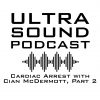The PENG block stands for PEricapsular Nerve Group block and looks to be a phenomenal block for hip and femoral neck fractures. Hear all about it in this week’s podcast featuring Dan Mantuani, Rob Farrow and Josh Luftig. Check out the video below!
Missed Castlefest 2020? Check out the whole conference on-demand here: https://courses.coreultrasound.com
Interested in an online ultrasound fellowship? Check out the Ultrasound Leadership Academy: http://ultrasoundleadershipacademy.com/academy/




